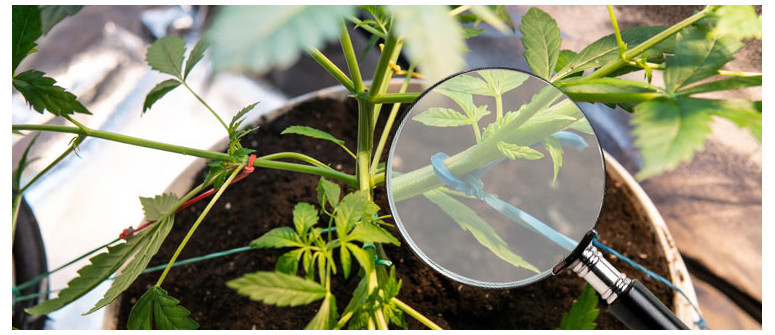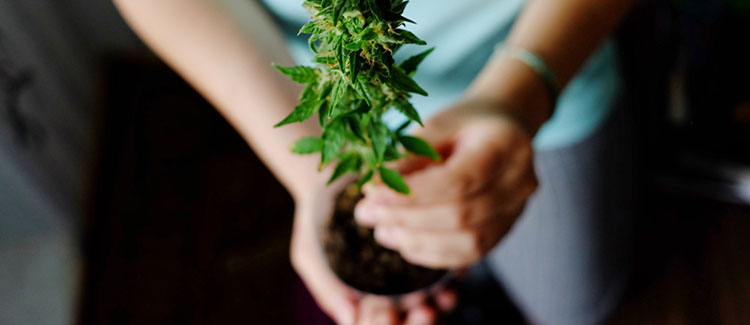Guide to low-stress training (LST technique) for cannabis plants

Low stress training is a relatively simple technique that involves bending and securing stems and branches with rope/string to "teach" a plant to grow in a specific way.
'Low Stress Training' is a relatively simple technique that involves bending and securing stems and branches with rope/string to "teach" a plant to grow in a specific way. It's often referred to as 'LST-technique' or just 'LST'.
Cannabis plants need plenty of light in order to produce great buds. Unfortunately, the lower parts of the plant naturally receive less light than those at the top, which is why they also tend to produce smaller, less potent flowers.
Low stress training is a great way to widen out your plant’s canopy so all parts of it receive the same amount of light and produce bigger, better buds come harvest time.
WHAT IS LOW STRESS TRAINING?
As the name suggests, LST techniques focus on causing as little stress to a plant as possible, so as to minimise the amount of time the plant will need to recover from the training.
Like other training techniques, LST really focuses on making plants grow in a way that allows light from the sun or grow lamp to hit the canopy as evenly as possible. When cannabis plants grow naturally, the lower leaves and branches usually get notably less light than the branches at the top.
Low stress training can help you create a more even plant canopy and ensure all parts of your plant get as much light as possible. In return, you’ll be rewarded with larger yields of higher-quality buds.
WHY SHOULD I USE LST WITH MY PLANTS?
With all branches receiving an equal distribution of light, plants will be able to produce more auxins (natural growth hormones). Auxins are usually found in their highest concentrations towards the top of the plant, which is why the lower parts produce smaller, lighter buds.
In undisturbed plants, they are responsible for apical dominance, making the top bud biggest and keeping the lateral branches from intensive development. When this natural process is disrupted by topping or LST, plants get a signal to develop more lateral branches.
Obviously, there are many other ways to train cannabis plants to grow in a specific way. However, techniques like topping, for example, put your plants under a lot of stress, from which they’ll need sufficient time to recover. Topping is therefore known as a high stress training (HST) technique.
MASSAGING OF STEMS AND BRANCHES

One of the options to "warm-up" your plants before LST is a technique known as massaging the stems and branches. Some growers dedicate extra few minutes every day in order to "massage" young and newly developed branches in order to make them stronger.
It is usually done by gentle grabbing of stems between fingers and slightly twisting and bending them around for few seconds per branch. These little movements tend to create micro fractures in the plants tissue, which in a way promote healthy growth and sturdiness in plants, resembling to micro damage that might be caused by wind blows which we do not encounter indoors.
Massaged plants are reported to grow thicker stalks and develop stronger lateral branches, being able to hold up bigger fruit load in the future.
LOW STRESS TRAINING TIPS
There are many different low stress training techniques out there, and most growers have their own unique approach. Below, we’ve created a basic step-by-step outline to help you get started with LST. Feel free to use this approach as is, or modify it as you see fit.
Notes: You’ll only want to begin training plants that have developed at least 4 or 5 nodes. Plants smaller than this will likely have fragile rooting systems and will uproot if you try to bend and train them.
Also, make sure the plants you train aren’t too old, either. Older plants tend to have hard, woody branches that are less flexible and more susceptible to breaking.
When training a plant, you’ll want to tie it down using string or nylon cord. So, before you get started, make sure you have something to hold your string in place. A good idea is to make small holes just underneath the rim of your pot, through which you can secure the string after tying it to the branches.
- The first part of the plant you'll want to train is the main stem. You should be able to secure your stem with 2 pieces of string: one about 1–2 inches from the tip of the plant, and another roughly 1–2 inches from the bottom.
- Start from the tip of your stem and bend it down so it is no longer the highest point of your plant. Once you’ve bent the tip as low as you can/want, secure it with a piece of string or nylon. Run the string through the hole you made in the brim, up and around the branch and then back down to the brim of the pot. Make sure to tie it down securely to hold the branch in place.
- Now that you’ve tied down the tip of your stem, you’ll want to do the same around the bottom of the stem. Note that the higher, thinner parts of the stem will bend more easily than the lower parts, so be extra gentle to avoid breaking the stem during this step. Once you’ve bent the stem back as much as possible, secure it with string or nylon cord like the above.
- Now it’s time to get to work on the other branches of the plant. Start by working on the top branches first. You’ll want to bend them back like you did with the stem, but also outward. This will make sure that the branches and leaves at the top of the plant don’t block any light from getting to those at the bottom. Once you’ve bent a branch, make sure to secure it down with your string.
- Work your way down the stem until all your branches are bent back. Once you’re done, it's a good idea to place your plant back under its light source to check if the light is distributed equally.
Note: When tieing a rope or string around a stem always keep it loose. Some space need to be left for the development of new tissues. If the loop is too tight, the branch will suffocate.
CAN I USE LOW STRESS TRAINING ON ANY CANNABIS STRAIN?
Yes, any strain can be trained using the above LST technique. If you’re using indica strains, you’ll find LST is a great way to get the lower parts of the plant to shine, as they’re usually left with little-to-no light by the end of the vegetative phase.
If you’re using sativas, on the other hand, LST can be a great way to control the height of your plants, especially if you're growing a strain that’s known to stretch a ton. Even next-gen autoflowering strains can undergo LST to great effect.
.jpg)
.jpg)

.jpg)
